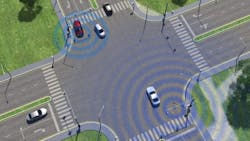The future of autonomy: When the traffic light tells you it’s OK to text
One of the critical needs for fully- and semi-autonomous vehicle systems to function properly is a line of communication between self-driving cars and trucks and the infrastructure surrounding them, according to, Andrew Silver – co-founder and chief technology officer for Tango Networks, a mobile device management system developer. He argues in this guest column that “Vehicle to Infrastructure” (V2I) connections could also help reduce distracted driver behaviors as well.
Today’s rudimentary autonomous driving systems are pointing the way to a future of increasingly smart vehicles and smart environments.
The cars of the future will perceive and act on their environments in ways that human drivers can’t today. As these innovations mature, they will reduce many of the risky distracted driving behaviors that have led to a sharp rise in traffic fatalities.
Central to this trend is an emerging innovation called V2I communication that creates a “smart” motorway infrastructure. This concept involves a vehicle receiving real-time status information wirelessly from roadway infrastructure such as traffic lights.
The City of Frisco in Texas recently became one of the first cities to adopt V2I technologies, establishing communication from traffic signals to cars. Approximately 100 intersections in Frisco have received connected car upgrades, according to Traffic Technology Services.
A recent demonstration conducted in conjunction with Audi illustrates the function of such technologies: The intersections send data on the status of the traffic lights to the connected Audi vehicles, and then a timer on the car’s dashboard shows a countdown until the traffic light will turn green, for example.
It’s a first step in providing a rich, connected driving experience that will enhance safety and efficiency.
Earlier this year, the U.S. Department of Transportation released guidance designed to better define and standardize the V2I technologies and deployment considerations.
This technology promises to make vehicles truly “smart and sensing,” eventually having the ability to adjust to conditions on the fly in ways that humans can’t.
Those innovations should enhance the development of fully automated self-driving vehicles since they will enable vehicles to sense and respond to the real-time data about roadway conditions.
Yet it could also help address the issue of distracted driving. Drivers who are distracted by mobile phones for example are believed to have become a major contributor to the sharp rise in motor vehicle deaths.
Autonomous driving promises to put an end to distracted driving, but only once the cars reach the highest level of automation. That’s still some years away.
For example, the National Safety Council (NSC) noted that very point regarding the recent findings by the National Transportation Safety Board that a truck driver’s failure to yield the right of way and a car driver’s inattention due to over-reliance on his Tesla’s automated driving system are the probable cause of the fatal crash near Williston, Florida, back in May of 2016.
“This crash serves as a stark reminder that cars cannot yet drive themselves,” the NSC said in a statememt. “We must understand the systems in our vehicles and how to properly interface with them so they provide the intended safety benefits. We are still decades away from an autonomous fleet [so] it is critical to remember that the driver still is the car’s best safety feature, and humans are the ‘self’ in ‘self-driving.’”
Yet the outlines of a future with fully-connected and fully-automated driverless vehicles are visible today.
In fact, V2I technologies could provide important interim safety benefits until practical fully automated driverless vehicles become available.As the NSC noted, today’s semi-autonomous vehicles and production cars for the foreseeable future will require a human driver to remain alert and ready to take control of the vehicle at any moment.
It is only at the highest level of autonomous vehicle development – fully automated self-driving cars – that it will be safe for a driver to text on a mobile phone while the vehicle is in motion.
But what if a V2I connected car could sense from the surrounding infrastructure when it was safe for the driver to go ahead and text for a short period waiting at a traffic light?
And what if the system could automatically enable the texting function on the driver’s phone, but then shut it off when the driver’s attention was needed back to the road?
That’s exactly the kind of potential benefit V2I could bring. Picture this scenario:
- The driver of a V2I connected car comes to a stop at connected traffic light that is red. A notification pops up on the car’s dash and the driver’s mobile phone that it is OK to text. A network-based mobile policy enforcement system automatically enables texting capability from the driver’s phone.
- As the driver sends texts, another notification pops up on their phone that the light will turn green in 15 seconds and then counts down this remaining time.
- The driver can finish their texts and then turn their attention fully back on the road when the light turns green. With 5 seconds remaining until the light turns to green, the policy enforcement system disables the texting function on their phone.
Because the policies are enforced in the network and tied to the status of the vehicle and the information coming from the infrastructure, there is no way for the driver to turn off the limitations or do an “end run” around them.
This communication and interaction of traffic light, car and mobile policy enforcement system provides a way for drivers to text safely and responsibly. Similarly this can be applied to other applications including social media or media consumption.
As we have seen from the traffic fatality statistics, distracted driving caused by mobile devices is not going to be resolved solely by legislation and law enforcement.
But technology is available today to nip the problem in the bud by preventing the unsafe, risky behavior in the first place.
These technologies will have a hand in enhancing our safety and driving experience as we move further into the exciting future of driverless motoring.


